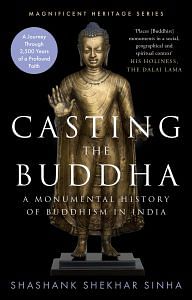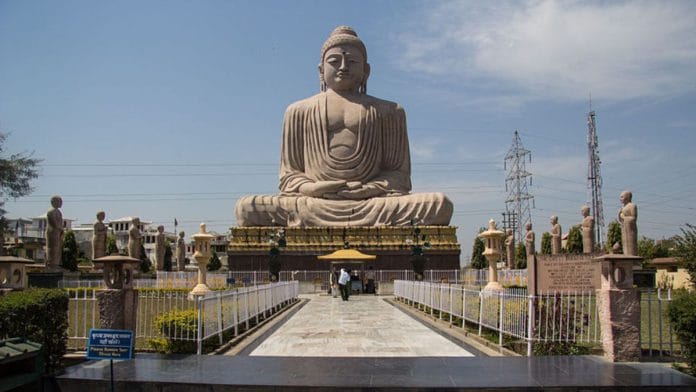The Buddha and Bodh Gaya figured prominently in independent India’s relationship with other Asian countries that had Buddhist populations. Its first prime minister, Jawaharlal Nehru, saw in Bodh Gaya an important cultural and symbolic resource for strengthening a nation-state and projecting India as a culture superpower among the other newly independent Asian nations.
The Bihar government was a happy ally in this scheme, as it ushered in tourism and economic development for the state. In the preceding section, we discussed how the Maha Bodhi Society played an important role in kindling a pan-Asian Buddhist revivalism around Bodh Gaya. Developments in independent India further gravitated towards making Mahabodhi Temple the navel of the earth and the centre of the Buddhist world once again.
The Indian government decided to celebrate the 2,500th anniversary of parinirvana of ‘one of the greatest sons of India’ (the Buddha) in a grand way. The year-long event in 1956, particularly the three-day Buddha Jayanti celebrations, was attended by thousands of Buddhists from outside India and delegations from Asian countries. This landmark occasion served to revive Buddhism in Bodh Gaya and revitalize its key Asian connections.
The central government also constituted the Bodh Gaya Temple Advisory Board in the same year. With the help of representatives from various nations, this board was handed the task of allotting land for the construction of Buddhist monasteries, temples and resthouses. Following the Chinese occupation of Tibet in 1959, Bodh Gaya (alongside Dharamshala) became an integral part of the exile geography of Tibetan Buddhists led by the Dalai Lama.
The subsequent decades saw the establishment of temples and monasteries by Asian countries with large Buddhist populations, including Burma, Thailand, Tibet, China, Vietnam, Korea, Japan, Sri Lanka and Bangladesh. This process picked up further momentum after the 1980s. Most such structures, particularly those built after the 1980s, represented the unique aesthetic and architectural styles of different Buddhist traditions prevalent among different nations.
The emergence of such monasteries, temples and guest houses also brought diasporic communities that followed their respective forms of worship and veneration. Visually, the structures with different architectural styles and the varied forms of worship give us a sense of the diverse forms of Buddhism prevalent across Asia and beyond. These brought about a dramatic transformation in Bodh Gaya’s physical and cultural landscape.
The proliferation of new monastic establishments and diasporic communities, together with a global dissemination and exchange of Buddhist ideas, practices, institutions and teachers, invested this sacred site with a pan-Asian Buddhist identity. The sponsoring of Buddha centred activities by these international establishments and communities, with the support of prominent Buddhist leaders and the central and Bihar governments, led to further ‘Buddhification’ of the sacred space at Bodh Gaya.
Also read: How the Vietnam War helped more Indian doctors migrate to the US in 1970s
These include the construction of the Buddha’s images (such as the giant statue provided by the Daijokyo sect of Nagoya, Japan, which was unveiled in 1989) and the celebration of public rituals such as the famous Tibetan Kalachakra ceremonies. The Dalai Lama has conducted five Kalachakra initiations in Bodh Gaya (1974, 1985, 2003, 2012, and 2017) and the one held in 1985 attracted a quarter of a million participants from thirty-one countries.
The post-liberalization phase in India accelerated the growth of Buddhist monasteries and religious shrines, along with upscaling tourist infrastructure like roads, meditation centres, hotels, restaurants and cafes at Bodh Gaya. Currently, Bodh Gaya has more than 100 monasteries or establishments sponsored by different countries. Post the year 2000, new dynamics contributed significantly to the site’s global identity and its universal appeal as a supreme pilgrimage site.
These include Bodh Gaya being designated as a UNESCO World Heritage Site status (2002), the inauguration of Gaya International Airport (2002) and the celebration of the 2,550th anniversary of the Buddha’s parinirvana in 2006. These developments tremendously enhanced the site’s tourism potential. In 2009, Bodh Gaya attracted 420,000 foreign tourists, overtaking Goa as the most popular destination. By 2011, the figures for overseas tourists had doubled to 972,487.57 Domestic tourism has grown, too. The surge in tourism has led to the area around the Mahabodhi temple complex being dotted with resthouses, restaurants, souvenir shops, internet cafes, handicraft shops, travel agencies, book shops and daily provision shops, besides trained and untrained guides, hawkers, informal sellers, casual workers and beggars.
Rapid changes to Bodh Gaya’s physical and cultural landscapes, and the status of a World Heritage Site, have also set into motion new problems and contestations. The UNESCO advisers, for instance, have suggested a comprehensive redevelopment of the town to facilitate international tourist traffic. In 2006, the Bihar Government in collaboration with Housing and Urban Development Corporation (HUDCO) published the City Development Plan (CDP) for Bodh Gaya which proposes a creation of a restricted buffer zone around the Mahabodhi temple. The central and state governments’ attempts at formulating plans to enhance the site’s tourism potential have met with strong resistance from locals who have socio-economic interests in the area surrounding the Mahabodhi temple.
Bodh Gaya, which has historically remained a site of contestations between the Buddhists and Hindus, is faced with a new problem – those who see it chiefly as a lucrative tourist destination versus those who see it as a pilgrimage site. The latter has brought about the coming together of some unlikely allies, including the Maha Bodhi Society, the Hindu mahant, foreign Buddhist temples and the local businesspeople. Meanwhile, considering the growing Asian identity of the site, the Bihar government, in July 2023, constituted a new advisory board that will direct the Bodhgaya Temple Management Committee on all matters related to the protection and management of the site.
The new committee includes ambassadors of Myanmar, Bhutan, Thailand, Japan, Cambodia, Mongolia, South Korea, Vietnam, Laos and the high commissioner of Sri Lanka, besides government officials, legislators and a representative of the Dalai Lama. While deliberations and contestations continue to surround Bodh Gaya, its sacred landscape continues to change like never before. In 2023, India’s largest reclining statue of the Buddha was inaugurated at the site where he attained enlightenment.
Two other recent developments are particularly relevant here. A geo-spatial study of the Mahabodhi temple complex conducted in 2023 revealed the presence of architectural structures beneath the temple and its surroundings. The study was conducted by Bihar Heritage Development Society (BHDS) and Cardiff University (United Kingdom) using ground surveys and satellite images. While excavations are awaited, this could potentially mean that the temple complex extended beyond its current boundaries.
And, in 2024, the National Democratic Alliance (NDA) government announced a plan in its budget to develop a Kashi-Vishwanath temple-style corridor in Vishnupad temple at Gaya, and Mahabodhi temple at Bodh Gaya. Perhaps a remaking of the World heritage Site is in the offing. The future of Bodh Gaya depends on how these plans pan out.
 This excerpt from ‘Casting The Buddha: A Monumental History of Buddhism in India’ by Shashank Shekhar Sinha has been published with permission from Pan Macmillan India.
This excerpt from ‘Casting The Buddha: A Monumental History of Buddhism in India’ by Shashank Shekhar Sinha has been published with permission from Pan Macmillan India.







Why was a secular Nehru government promoting a religion when there were so many misgivings about participating in the Somanath temple construction. Looks like Nehru’s secularism was selective.
Not selective, promoting bodh gya was essential because that time india was leading the NAM… if you have some little knowledge about NAM then you never point out the thought about selective secularism. About nehru on somnath I argue him about this arnea but when we saw the letter he also put that we don’t have capital for the somnath so he focus on Dams for mass agriculture production after eve of independence. And also put that Dams is the modern temple of India, Bhakra nanga Dam..
Sorry for my some grammar mistakes as well spelling .